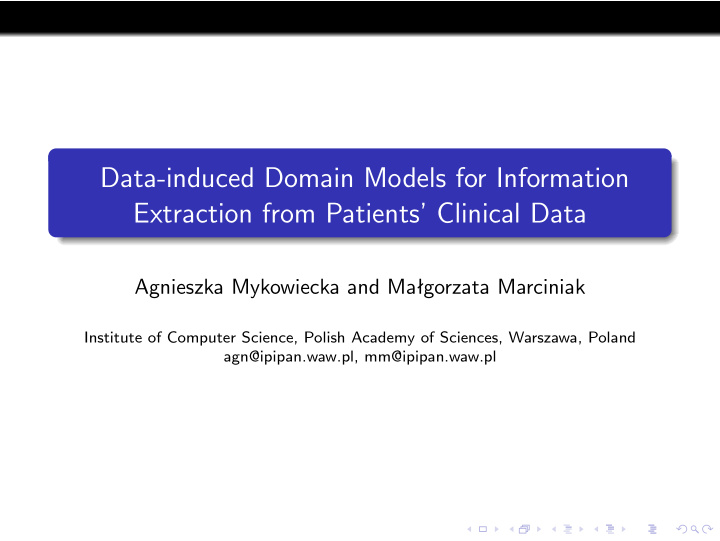



Data-induced Domain Models for Information Extraction from Patients’ Clinical Data Agnieszka Mykowiecka and Małgorzata Marciniak Institute of Computer Science, Polish Academy of Sciences, Warszawa, Poland agn@ipipan.waw.pl, mm@ipipan.waw.pl
Overview rule-based medical information extraction (IE) for Polish medical texts using specially defined domain ontologies (first such an experiment carried out for Polish – a highly inflected and relatively free-word order language), two IE applications designed to select data from patients’ documentation ( mammogram notes and diabetic patients’ hospital records ) in Polish (unrestricted free texts), for most features precision and recall well above 80% were obtained.
Processing Stages ✓ ✏ Ontology ✒ ✑ Preprocessing ❄ Domain Model ✛ ❄ ❄ IE rules Domain Lexicon ✛ ② ❳ ❳ ❳ ❳ ❳ ❳ ❳ Morfological Lexicon ❳ ❄ Postprocessing ✘✘✘✘✘✘✘✘✘ ✿ ✘ SQL queries ❄ Database ✲ Simple query interface
Ontology The ontology covers only the chosen medicine subdomains but it is coherent and can be further extended. At the moment only high level concepts are shared between domains. Some fragments of more general ontologies have been also defined: PhysicalFeature, PhysicalFeatureComparison and Time . They cover such physical features as size, contour, aggregation, density, projection and regularity and comparisons of quantity, degree and level. Time ontology covers only those cases which occur in selected type of documents. This means period of time in years, months and weeks, precise and imprecise dates, and also repetitions like every year . The ontology was manually translated into a TFS hierarchy. This resulted in 176 types with 66 attributes for the mammography domain and 139 types with 65 attributes for the diabetes.
IE-rule An exemplary (simplified) rule cited below states that there are no long-lasting complications of diabetes of a certain type (identified as a gazetteer entry denoting a complication — variable #t). brak powiklan:> morph & [STEM "nie"] (morph & [STEM "stwierdzić"] | morph & [STEM "wykryć"]) (morph & [STEM "obecność"])? morph & [STEM "późny"] (morph & [STEM "cukrzycowy"] | morph & [STEM "cukrzyca"]) (morph & [STEM "w"] | morph & [STEM "pod"] ) (morph & [STEM "postać"] | morph & [STEM "typ"] ]) gazetteer & [GTYPE gaz comp, G CONCEPT #t] -> no comp str & [N COMP #t].
Selected results Evaluation results for selected attributes for the 705 mammography reports: cases precision recall findings 343 90.76 97.38 block beginnings 299 81.25 97.07 localizations 2189 98.42 99.59 Evaluation results for selected attributes for the 100 diabetes reports: cases precision recall unbalanced diabetes 58 96,67 69,05 diabetic education 39 97,50 97,50 neuropathy 30 100 96,77
Conclusions rule-based IE applications using domain ontologies and linguistic data are capable for extracting very detailed specific information from texts in natural languages, for the selected task of IE from patients’ clinical data, reusing existing ontologies was impossible due to the lack of appropriate resources, for methods applying NLP techniques, restricted simplified domain ontologies are necessary – good solution would be to enhance ontologies with a concept of views, for processing of languages with rich inflection patterns, ontologies should be linked with inflectional dictionaries.
Recommend
More recommend